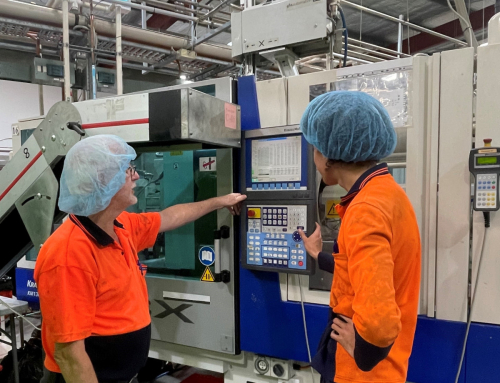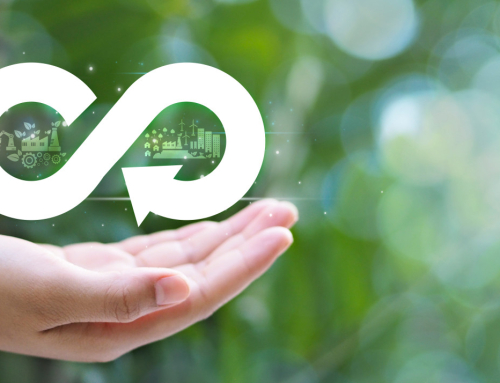What is plastic injection molding?
In plastic injection molding, plastic pellets are fed through a hopper system and into a barrel with heater bands. As the pellets move through the heated barrel they become molten and are injected into the mold which is clamped closed. The terms ”mold” and “tool” are often used interchangeably. After the mold is filled, the polymer cools until it solidifies, conforming to the shape of the mold. The mold then opens, ejects the molded part and the process repeats.
A modern injection molding machine has three main parts:
- the mold
- the injection unit, and
- the clamp.
The Invention and Evolution of Plastics Injection Molding Technology
An early type of synthetic plastic known as ‘Celluloid’, which was transparent, flexible and waterproof, was developed in 1868 by John Wesley Hyatt (1837–1920), an inventor and industrialist. Hyatt and his brother Isaiah Smith Hyatt (1835–1885) then patented the first injection molding machine in 1872.
The device they patented was like a hypodermic needle, with a plunger that forced or ‘injected’ the molten plastic material, which had been heated in a cylinder, into the mold. Initially, this process was used to make a range of popular household items, with celluloid buttons and toys replacing those formerly made from ivory, shell or horn; and celluloid collars, cuffs and shirtfronts replacing those formerly made from paper.
The machinery to mold plastic material was refined much later, in 1946, when inventor James Watson Hendry patented the first extrusion screw injection machine, which enabled greater control over the speed of injection and the plastic items produced. His machinery also allowed for recycled or coloured plastic to be combined with the raw material before injection.
As different types of plastics were developed in the 20th century, injection molding factories were able to manufacture a wider variety of components for consumer products, including car parts, and for medical instruments.
Why do customers require plastic injection molding?
Customers come to W&S Plastics requiring injection molding services for a variety of reasons. Examples include:
- Designing, building and testing the tool that will produce their plastic products;
- Molding components that form part of an assembly for EOM’s in a multitude of industries including medical and electronics;
- Molding and assembling customers products, which then leave W&S and go straight to stores for sale
Customers will come to us to help refine a prototype for their product idea. We can produce 3D models, 3D printed parts, and produce drawings before we proceed to manufacturing. We simulate the part in our software to analyse how the plastic will fill and flow in the mold during manufacturing. This allows us to iterate the design in partnership with our customer, and we can solve potential problems well before the customer commits to tooling for the product, saving time and money.
What type of injection molding services does W&S Plastics offer?
W&S Plastics works with an extensive range of plastics, and can mold plastic products from every chemical group currently available.
We provide the full range of injection molding services at W&S Plastics:
- Standard or Traditional Molding
- Insert Molding
- Over Molding
- Co Molding
With Insert Molding a plastic or metal insert is placed in the open mold, which then shuts and holds the insert in place. The process injects the plastic around the insert. The end result is a plastic part with an integrated metal or plastic insert. This can bond a plastic thread to a metal component firmly enough to make household items that are regularly unscrewed.
Common product example: threaded impellers for pumps.
Over Molding involves molding onto a part that has already been molded in another machine, with the first molded part being made from plastic. Transfer over molding is the automated form of the process, where a robot transfers the first molded part to a different molding machine for the over molding phase. Transfer over molding is suited to large quantities.
Common product example: automotive tail lamp lenses
The ultimate over molding process known as Co-Molding is only used when components are specifically designed for it. It is a process whereby a part with 2 or more materials is produced in the one machine. After the plastic in the base mold cools, a cavity is created with a second ‘gate’. A different plastic material is injected to fill that cavity.
Common product example: Multi colored toothbrushes.
Why do customers choose injection molding manufactured locally?
Customers in Australia, or in Malaysia (and Singapore) have the convenience of local manufacturing, as there are W&S Plastics factories located in Sydney, Australia, and at Kulai in the state of Johor, Malaysia.
Local manufacturing plants enable us to be close to our customers, providing shorter lead times and fewer disruptions to supply chains. During the pandemic, our onshore production gave customers a critical advantage.
What is the difference in a quality injection molding process?
At W&S Plastics we have been manufacturing since 1978, and over the decades we have developed premium quality molding procedures. The difference for customers is that they can rely on the durability, repeatability and functionality of the high quality molding that W&S Plastics provides using state-of-the-art injection molding machinery.
Employees work in controlled conditions. Our Sydney clean room is bio controlled. The production area of our Malaysian plant is ISO 8 clean room certified, and we also have a second facility with an ISO 7 certified clean room for assembly.
We also comply with international standards and certification. For example, our commitment to protecting and preserving our environment is demonstrated by our ISO14001, Environmental Management Systems and ISCC Plus, International Sustainability & Carbon Certification. All our facilities conform to ISO 13485 for medical device manufacture.
Can injection molding incorporate recycled materials?
Recycled plastic has been used since the 1940s, when new injection molding machinery allowed recycled material to be added to virgin materials then thoroughly mixed and coloured together prior to being injected into the mold.
At W&S Plastics, we work with clients to create products using recycled plastics as part of our commitment to the circular economy. This approach involves using polymers generated from advanced recycling processes to make plastic.
Injection molding machines at W&S Plastics
At our Sydney factory our injection molding machines can manage 20 to 750 tonnes clamping force requirements. We have the latest in injection molding technology, such as:
- Engel Injection Molding machines
- Arburg Injection Molding machines
- Kraus Maffi Injection Molding machines
Our Johor factory has injection molding machines that cover 60 to 450 tonnes clamping force requirements. We also have the latest in injection molding technology, such as:
- Engel Injection Molding machines
Drying equipment is also essential to the process. Our Sydney factory uses Moretto central drying equipment and our Johor factory uses Motan drying equipment. Both dry the air to -40°C dew point prior to heating it to the recommended temperature for drying the polymer by employing silicon desiccant technology.
Interesting products made possible by injection molding
At W&S Plastics we have used injection molding processes to produce thousands of items, from essential medical and emergency equipment to fun toys. These include:
- Ventilators/ventilator components
- Sleep apnoea machines
- IVF devices and components
- Sharps disposal containers
- Protective eyes shields and other PPE in common use since the pandemic
- Blanking caps for firefighting
- Water pumps
- Street lighting controls
- Plumbing fittings
- Farming equipment components
- Mouth guards for sportspeople
- Cake decorating components
- Fishing lures
- 3D printer housings
- Medical sterilisation components
For more details on our innovative molded products see our case studies page.
What other services are offered by W&S Plastics?
Plastic injection molding is our core business. We also offer customers product finishing – post molding processes that achieve quality finished molded products.
These post molding processes include:
- Pad printing
- Screen printing
- Hot foil printing
- Ultrasonic welding
- Sonic fastener insertion
- Vibration welding
- Laser cutting
- Laser marking
- Assembly
- Packaging
We also have tool-making capabilities in both our Sydney and Johor plants.
If you have developed a project that needs molding, contact our customer division at W&S Plastics on +61 2 8778 7444 or via email info.wsp1@wsplastics.com.au to discuss the solutions that our quality plastic injection moldings can provide.







